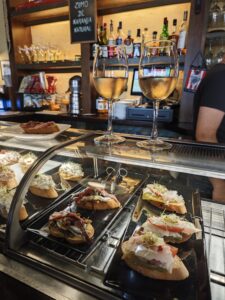The Txakoli Effect: a closer look at modern Basque wines
The Basque Country is a region in northern Spain that seems to have its own unique recipe for creating miracles.
The first inspiring example is the collaborative movement of Basque chefs in the 1970s, which not only transformed rustic regional cuisine into Basque ‘nouvelle cuisine’ and Basque ‘haute cuisine’, but also provided the impetus for even more fundamental changes. Thanks to this creative synergy, Basque chefs have managed to associate the image of the Basque Country so closely with gastronomy that today it is one of the main pillars of the Basque tourist brand, with such outstanding results. San Sebastian has become one of the most important gastronomic destinations in the world.
Another example of the Basque miracle is the Bilbao effect, named after Frank Gehry’s Guggenheim Museum in Bilbao, whose remarkable success led to transformative changes in the city of Bilbao. This cultural investment has also influenced the image of the Basque Country, taking its perception to the next level.
And today we are witnessing the next miracle – the Txakoli effect. Txakoli has deep roots in the Basque Country, with references to its production dating back to the Middle Ages. But until the 1980s, txakoli was a rustic, low-alcohol wine consumed locally by farmers and fishermen. The situation changed with a concerted effort by local producers to modernise winemaking techniques and improve quality, elevating Txakoli to a premium product. By prioritising quality, the former house wine has become a fine symbol of Basque identity, helping to transform the region into an exciting wine destination.
Let’s discover the modern Txakoli wines together!
Txakoli: the name of the wine, not the grape
The name itself – Txakoli (cha-koh-lee) – comes from the subsistence farming era, when all household products, vegetables and fruit, including grapes, were grown and produced not for sale but primarily for the family’s own consumption.
If a crop produced more than the family needed in a given year, it could be exchanged with neighbours or sold. But if the yield was poor, they would definitely keep it for their own consumption. The name ‘txakoli’ means ‘I keep it for myself’. Poor harvests were common, so the name stuck.
Today, most txakoli wines are still drunk “at home” – in the Basque Country. It is the favourite wine of the Basques themselves, generously shared with thirsty tourists.
Basque grape varieties
Txakoli wine is mainly made from native grape varieties. It’s allowed to use in blends up to 20% of some international varieties like Riesling, Chardonnay, Sauvignon Blanc. Most of the wine produced is white. The volume of rosé and red txakoli is still small, but growing.
The name of the main Basque grape varieties comes from the town of Hondarribia, on the border between what is now Spain and France. During the Roman Empire, it was an important logistical point for trade and communication on the north coast. It is thought that the vines brought by the Romans spread from here to the whole region, retaining the name of their origin.
The most important Basque grape varieties are
- Hondarrabi Zuri: The main grape variety, which accounts for the majority of txakoli production. It produces wines with high acidity, citrus notes and a characteristic salty edge.
- Hondarrabi Zuri Zerratia: White grape with smaller berries and more compact clusters, contributing some herbal and vegetal aromas.
- Hondarrabi Beltza: A red variety that recent genetic tests have confirmed is closely linked to Cabernet Franc. Used mainly in white blends to add fruity flavours and complexity, it is also used in rosé txakoli and red monovarietal txakoli.

Basque terroir – main influences
The character of txakoli is shaped by the unique geography of the Basque Country, with its rugged coastline and steep slopes. The Atlantic climate brings high humidity and rainfall (an average of 1000-1600 mm per year), which increases the risk of fungal diseases and mould, but also strong winds that help to ventilate the vineyards.
To make the most of this natural ‘air conditioning’, the vines are trained high in the traditional pergola form called ‘parral’. In this way, the wind provides good ventilation under the vines, creating a special microclimate in the vineyards and minimising the risk of fungal diseases. Vineyards are mainly planted on steep slopes to maximise sun exposure and drainage, but hillsides also make them unsuitable for mechanisation. Most of the work in Basque vineyards, including harvesting, is demanding and done by hand. Despite the harsh growing conditions, the Basque terroir contributes to the unique freshness, vibrant acidity and crisp character of txakoli.
The txakoli production area is divided into 3 DOs:
- Getaria (DO Getariako Txakolina): The most famous and historic Txakoli appellation, located near the coast, around Getaria and Zarautz. Produces wines with more pronounced herbal notes and higher acidity.
- Bizkaia (DO Bizkaiko Txakolina): The largest DO, partly situated on the coast and partly inland, protected from the Atlantic influence. White and red wines are produced.
- Álava (DO Arabako Txakolina): The most inland of the three, with a slightly warmer climate. This DO area is maximally protected from the Atlantic influence – more fruity flavour and slightly lower acidity.
 What is the typical modern Txakoli style?
What is the typical modern Txakoli style?
Txakoli wines have evolved from simple, rustic wines into not one, but many different styles of wine. As well as simple, yet refined and fresh wines, Basque producers offer wines with more complex and layered flavours, enhanced by contact with lees and oak fermentation and ageing. Nevertheless, all Txakoli wines proudly display the influence of the Basque terroir and their distinctive character, with a focus on freshness, steely acidity, crispness, elegant fruity and herbaceous notes balanced by salty accents.
The harvest for both the white and red Txakoli wines is planned with the aim of preserving the acidity of the grapes, but also to ensure that they reach ripeness. Therefore, the level of distinctive herbaceous, ‘green’ flavours will still be present in the wine, but not overwhelming.
Traditionally, txakoli wines were fermented in large chestnut vats. Nowadays, stainless steel tanks are used to preserve the vibrant fruit character and freshness of the wine. Some producers also successfully ferment txakoli in barrels.
The main characteristics of txakoli wine:
- Light – medium (-) bodied wine with low alcohol – 9.5 – 11.5 abv
- Refreshing, high acidity, balanced by elegant and clean flavours, overall zesty character
- The light CO2 content gives the wine a tickling sensation through micro-bubbles, creating a light effervescent effect.
Typical aromas and flavours:
White txakoli: Aromas and flavours of low/medium intensity, fresh green apple, gooseberry, green pear, meyer lemon, lime, grapefruit zest, freshly cut grass, tomato leaf, blackcurrant leaf, floral notes, sea salt finish
Colour – light/medium lemon, green lemon with greenish hues.
Rosé txakoli: Aromas and flavours of low/medium intensity, red and white currant, raspberry, fresh strawberry and berry sorbet, white pepper, floral notes, often with a salty finish
Colour – light pink
Red txakoli: Aromas and flavours of medium intensity, freshly cut grass and fresh aromatic herbs – sage, savory, marjoram, tomato stems, blackcurrant leaves, fresh and juicy red fruits such as redcurrants, sour cherries, raspberries, spicy finish with white pepper, ginger notes.
Colour – medium purple, ruby
Traditionally txakoli wines were intended to be drunk within a year. Today most txakoli are also intended for early consumption. More complex wines with lees contact and oak aging can mature in the bottle and develop more complex profiles. Elegant and complex wines produced from old vines, some of which have reached the remarkable age of around 100 years.
 In harmony with fine cuisine
In harmony with fine cuisine
The modern txakoli wine, refined and elegant, with a bright acidity and effervescence, was born to be the ideal partner for a wide range of dishes.
It seems that extreme climatic conditions created the distinctive style of the wine and influenced its destiny – to be one of the most gastronomic wines in the world.
The most popular pairings with Txakoli include:
- Seafood: Grilled fish, octopus, anchovies, and bacalao (salt cod).
- Pintxos (Basque tapas): Anchovy-stuffed olives, tortilla de patatas, and jamón ibérico.
- Cheeses: Fresh goat’s cheese or Idiazábal, a Basque sheep’s milk cheese.
- Fritters: Tiny fried fish such as anchovies, sardines, but also fried calamari, potatoes and other fried dishes will benefit from being paired with refreshing txakoli
- Sushi and sashimi with txakoli is one of the rising gastronomic trends (just as Japan is one of the rising export markets for txakoli wines)
Txakoli wines, including reds, will perform the most impressively when served chilled to 7-10C. An aerator can be used for serving and it is recommended to hold the bottle slightly higher when pouring the txakoli wine into the glasses – a distance of 15-20 cm between the glass and the bottle would be sufficient. However, do not confuse this with the cider pouring technique used in Basque country, where the cider is poured onto the glasses from a distance of 50-60 cm. This way of serving is more suitable for cider rather than for txakoli wine, and this is another impressive story from this region…
Today, txakoli is more than just a niche wine. For tourists, txakoli is an invitation to visit the Basque Country as a wine destination and the best companion in pintxos bars. For wine professionals, its gastronomic appeal and flexibility are being increasingly appreciated by restaurant owners and chefs. And the most important thing about txakoli is that it is a wine that reflects the history, culture and landscape of the Basque Country. The latest Basque miracle in a glass.










